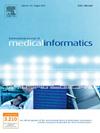IgA肾病牛津分型及预后预测的多任务深度序列神经网络
IF 4.1
2区 医学
Q2 COMPUTER SCIENCE, INFORMATION SYSTEMS
International Journal of Medical Informatics
Pub Date : 2025-07-18
DOI:10.1016/j.ijmedinf.2025.106052
引用次数: 0
摘要
虽然深度学习促进了IgA肾病(IgAN)的病理分析,但缺乏结合多标签结构识别、牛津分类和预后预测的集成模型仍然是一个重大的临床挑战。方法我们开发了DeepSNN,这是一种新型的深度序列神经网络,可作为多中心多模态肾脏数据集训练的多任务模型。该架构集成了病变分割、肾小球分类、牛津MEST-C评分和预后预测子网。为了确保可解释性,我们进行了可视化实验,并与病理学家的诊断模式进行了对比分析。病理学比较采用Cohen 's Kappa对测试和验证集进行盲法重新评估。结果deepsnn在解放军总医院数据集(n = 245)和中日友好医院数据集(n = 32)中表现出卓越的病变识别能力,分别实现了0.95和0.92的骰子系数。对于牛津分类,DeepSNN在PLAG数据集上的M、E、S、T和C得分Kappa值分别为0.84、0.79、0.87、0.87和0.82,取得了出色的结果。值得注意的是,我们的方法在两个数据集上都优于三位初级病理学家,并取得了与高级病理学家相当的表现。在47.7个月(IQR: 21.9-61.1)个月的中位随访期间,DeepSNN在预后预测方面表现出色(AUC: 0.810),优于PLAG医院数据集(n = 245)中的国际IgA肾病预测工具(IIPT) (AUC: 0.742, ΔAUC = +0.068)。此外,可视化地图显示病理学家和DeepSNN之间一致的病理区域识别。结论:deepsnn成功地集成了多种诊断任务,其性能可与高级病理学家相媲美,展示了简化IgAN临床工作流程的巨大潜力。这一创新解决了自动化肾脏病理分析的关键空白,同时保持了临床可解释性。本文章由计算机程序翻译,如有差异,请以英文原文为准。
A multi-task deep sequential neural network for IgA nephropathy Oxford classification and prognosis prediction
Background
While deep learning has advanced pathological analysis in IgA nephropathy (IgAN), the lack of integrated models that combine multi-label structural identification, Oxford classification, and prognosis prediction remains a significant clinical challenge.
Methods
We developed DeepSNN, a novel deep sequential neural network that serves as a multi-task model trained on multi-center multi-modal renal datasets. The architecture integrates lesion segmentation, glomerular classification, Oxford MEST-C scoring, and prognosis prediction subnets. To ensure interpretability, we conducted visualization experiments and comparative analyses with pathologists’ diagnostic patterns. Pathologist comparisons employed Cohen’s Kappa with blinded re-evaluation of test and validation sets.
Results
DeepSNN demonstrated exceptional lesion identification capabilities across the People’s Liberation Army General (PLAG) Hospital dataset (n = 245) and China-Japan Friendship (CJF) Hospital dataset (n = 32), achieving dice coefficients of 0.95 and 0.92, respectively. For Oxford classification, DeepSNN delivered outstanding outcomes with high Kappa values of 0.84, 0.79, 0.87, 0.87, and 0.82 for M, E, S, T, and C scores on the PLAG dataset. Notably, our method outperformed three junior pathologists and achieved comparable performance to senior pathologists across both datasets. During a median follow-up of 47.7 (IQR: 21.9–61.1) months, DeepSNN excelled in prognosis prediction (AUC: 0.810), demonstrating improvement over the International IgA Nephropathy Prediction Tool (IIPT) (AUC: 0.742, ΔAUC = +0.068) in PLAG Hospital dataset (n = 245). Furthermore, visualization maps showed consistent pathological region identification between pathologists and DeepSNN.
Conclusions
DeepSNN successfully integrates multiple diagnostic tasks with performance comparable to senior pathologists, demonstrating substantial potential for streamlining IgAN clinical workflows. This innovation addresses critical gaps in automated renal pathology analysis while maintaining clinical interpretability.
求助全文
通过发布文献求助,成功后即可免费获取论文全文。
去求助
来源期刊

International Journal of Medical Informatics
医学-计算机:信息系统
CiteScore
8.90
自引率
4.10%
发文量
217
审稿时长
42 days
期刊介绍:
International Journal of Medical Informatics provides an international medium for dissemination of original results and interpretative reviews concerning the field of medical informatics. The Journal emphasizes the evaluation of systems in healthcare settings.
The scope of journal covers:
Information systems, including national or international registration systems, hospital information systems, departmental and/or physician''s office systems, document handling systems, electronic medical record systems, standardization, systems integration etc.;
Computer-aided medical decision support systems using heuristic, algorithmic and/or statistical methods as exemplified in decision theory, protocol development, artificial intelligence, etc.
Educational computer based programs pertaining to medical informatics or medicine in general;
Organizational, economic, social, clinical impact, ethical and cost-benefit aspects of IT applications in health care.
 求助内容:
求助内容: 应助结果提醒方式:
应助结果提醒方式:


